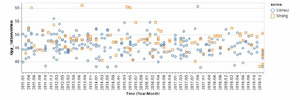Information
- Publication Type: Bachelor Thesis
- Workgroup(s)/Project(s):
- Date: June 2022
- Date (Start): 1. October 2021
- Date (End): 22. June 2022
- Matrikelnummer: 11822449
- First Supervisor: Eduard Gröller
Abstract
This Paper is centered around the topic of predicting the winner of a Tennis-Match on the ATP-Tour. Firstly there is a short introduction about the relevance and research of Machine Learning. At first the topic will be discussed broadly, then more and more narrowly to match the goal of the thesis. Next a research for important literature will be carried out, to present the state of the art in the field of Machine Learning based predictions, in science and on the market. Prediction algorithms will be discussed, with an emphasis on outcome prediction in different sports. As an important and high revenue usecase of prediction, the methods of betting companies and bookmakers also get a chapter to be discussed. Same applies to the visualization of data in conjunction to Machine Learning, related Frameworks and Libraries and lastly also future challenges of applying Machine Learning In the practical part of the thesis, an application will be talked about, that compares the performance of different neural Networks that try to predict the winner of a Tennis- Match. To accomplish that, at first a dataset with over 200.000 entries and more than 200 variables was split into four chunks to be the input for one neural Network each. Those neural Networks were made and trained in Tensorflow and their accuracy was tested via picking three players and trying to predict their matches. The results were then plotted into a Scatterplot. With this methodology it is possible to get information about what variables, that the public has access to before the match starts, are how important for the outcome of a match. Furthermore it would be feasible to find out, what set of variables is best suited to make predictions about the winner and also if there are differences in the predictions of the three players.Additional Files and Images
Weblinks
No further information available.BibTeX
@bachelorsthesis{Leutschacher_2022,
title = "Visual Analysis of the Prediction of ATP-Matches",
author = "Manuel Leutschacher",
year = "2022",
abstract = "This Paper is centered around the topic of predicting the
winner of a Tennis-Match on the ATP-Tour. Firstly there is a
short introduction about the relevance and research of
Machine Learning. At first the topic will be discussed
broadly, then more and more narrowly to match the goal of
the thesis. Next a research for important literature will be
carried out, to present the state of the art in the field of
Machine Learning based predictions, in science and on the
market. Prediction algorithms will be discussed, with an
emphasis on outcome prediction in different sports. As an
important and high revenue usecase of prediction, the
methods of betting companies and bookmakers also get a
chapter to be discussed. Same applies to the visualization
of data in conjunction to Machine Learning, related
Frameworks and Libraries and lastly also future challenges
of applying Machine Learning In the practical part of the
thesis, an application will be talked about, that compares
the performance of different neural Networks that try to
predict the winner of a Tennis- Match. To accomplish that,
at first a dataset with over 200.000 entries and more than
200 variables was split into four chunks to be the input for
one neural Network each. Those neural Networks were made and
trained in Tensorflow and their accuracy was tested via
picking three players and trying to predict their matches.
The results were then plotted into a Scatterplot. With this
methodology it is possible to get information about what
variables, that the public has access to before the match
starts, are how important for the outcome of a match.
Furthermore it would be feasible to find out, what set of
variables is best suited to make predictions about the
winner and also if there are differences in the predictions
of the three players. ",
month = jun,
address = "Favoritenstrasse 9-11/E193-02, A-1040 Vienna, Austria",
school = "Research Unit of Computer Graphics, Institute of Visual
Computing and Human-Centered Technology, Faculty of
Informatics, TU Wien ",
URL = "https://www.cg.tuwien.ac.at/research/publications/2022/Leutschacher_2022/",
}

 Bachelor thesis
Bachelor thesis Image
Image

